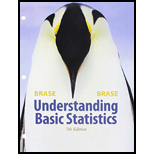
Concept explainers
FBI Report: Larceny Thirty small communities in Connecticut (population near 10.000 each) gave an average of
(a) Find a 90% confidence interval for the population
(c) Find a 99% confidence interval for the population mean annual number of reported larceny cases in such communities. What is the margin of error?
(d) Compare the margins of error for parts (a) through (c). As the confidence levels increase, do the margins of error increase?
(c) Critical Thinking Compare the lengths of the confidence intervals for parts (a) through (c). As the confidence levels increase, do the confidence intervals increase in length?
(a)
To find: The 90% confidence interval for the population mean annual number of reported larceny cases in such communities. Also find the margin of error.
Answer to Problem 19P
Solution:
The 90% confidence interval for
Explanation of Solution
Calculation:
Given that x be a random variable that represents the communities in Connecticut. The average of
We have to find 90% confidence interval,
90% confidence interval is
The 90% confidence interval for
Margin of error is
(b)
To find: A 95% confidence interval for the population mean annual number of reported larceny cases in such communities. Also find the margin of error.
Answer to Problem 19P
Solution:
The 95% confidence interval for
Explanation of Solution
Calculation:
Given that x be a random variable that represents the communities in Connecticut. The average of
We have to find 95% confidence interval,
95% confidence interval is
The 90% confidence interval for
Margin of error is
(c)
To find: A 99% confidence interval for the population mean annual number of reported larceny cases in such communities. Also find the margin of error.
Answer to Problem 19P
Solution:
The 99% confidence interval for
Explanation of Solution
Calculation:
Given that x be a random variable that represents the communities in Connecticut. The average of
We have to find 99% confidence interval,
99% confidence interval is
The 99% confidence interval for
Margin of error is
(d)
The comparison of the margins of error for part (a) through (c). Also determine whether the margins of error increases or decreases when confidence level increases.
Answer to Problem 19P
Solution:
The margins of errors increases as the confidence level increases.
Explanation of Solution
Calculation:
For 90% confidence interval, the margin of error is
For 95% confidence interval, the margin of error is
For 99% confidence interval, the margin of error is
As the confidence level increases the margins of errors also increases.
(e)
The comparison of confidence interval for part (a) through (c). Also determine whether the confidence intervals increases in length as confidence level increases.
Answer to Problem 19P
Solution:
The length of confidence interval increases as the confidence level increases.
Explanation of Solution
For 90%confidence interval, the length of confidence interval is
For 95%confidence interval, the length of confidence interval is
For 99%confidence interval, the length of confidence interval is
As the confidence level increases the length of confidence interval also increases.
Want to see more full solutions like this?
Chapter 8 Solutions
Bundle: Understanding Basic Statistics, Loose-leaf Version, 7th + WebAssign Printed Access Card for Brase/Brase's Understanding Basic Statistics, ... for Peck's Statistics: Learning from Data
- 15. This problem extends Problem 20.6. Let X, Y be random variables with finite mean. Show that 00 (P(X ≤ x ≤ Y) - P(X ≤ x ≤ X))dx = E Y — E X.arrow_forward(b) Define a simple random variable. Provide an example.arrow_forward17. (a) Define the distribution of a random variable X. (b) Define the distribution function of a random variable X. (c) State the properties of a distribution function. (d) Explain the difference between the distribution and the distribution function of X.arrow_forward
- 16. (a) Show that IA(w) is a random variable if and only if A E Farrow_forward15. Let 2 {1, 2,..., 6} and Fo({1, 2, 3, 4), (3, 4, 5, 6}). (a) Is the function X (w) = 21(3, 4) (w)+711.2,5,6) (w) a random variable? Explain. (b) Provide a function from 2 to R that is not a random variable with respect to (N, F). (c) Write the distribution of X. (d) Write and plot the distribution function of X.arrow_forward20. Define the o-field R2. Explain its relation to the o-field R.arrow_forward
- 7. Show that An → A as n→∞ I{An} - → I{A} as n→ ∞.arrow_forward7. (a) Show that if A,, is an increasing sequence of measurable sets with limit A = Un An, then P(A) is an increasing sequence converging to P(A). (b) Repeat the same for a decreasing sequence. (c) Show that the following inequalities hold: P (lim inf An) lim inf P(A) ≤ lim sup P(A) ≤ P(lim sup A). (d) Using the above inequalities, show that if A, A, then P(A) + P(A).arrow_forward19. (a) Define the joint distribution and joint distribution function of a bivariate ran- dom variable. (b) Define its marginal distributions and marginal distribution functions. (c) Explain how to compute the marginal distribution functions from the joint distribution function.arrow_forward
- 18. Define a bivariate random variable. Provide an example.arrow_forward6. (a) Let (, F, P) be a probability space. Explain when a subset of ?? is measurable and why. (b) Define a probability measure. (c) Using the probability axioms, show that if AC B, then P(A) < P(B). (d) Show that P(AUB) + P(A) + P(B) in general. Write down and prove the formula for the probability of the union of two sets.arrow_forward21. Prove that: {(a, b), - sa≤barrow_forwardarrow_back_iosSEE MORE QUESTIONSarrow_forward_ios
 Big Ideas Math A Bridge To Success Algebra 1: Stu...AlgebraISBN:9781680331141Author:HOUGHTON MIFFLIN HARCOURTPublisher:Houghton Mifflin Harcourt
Big Ideas Math A Bridge To Success Algebra 1: Stu...AlgebraISBN:9781680331141Author:HOUGHTON MIFFLIN HARCOURTPublisher:Houghton Mifflin Harcourt Glencoe Algebra 1, Student Edition, 9780079039897...AlgebraISBN:9780079039897Author:CarterPublisher:McGraw Hill
Glencoe Algebra 1, Student Edition, 9780079039897...AlgebraISBN:9780079039897Author:CarterPublisher:McGraw Hill

